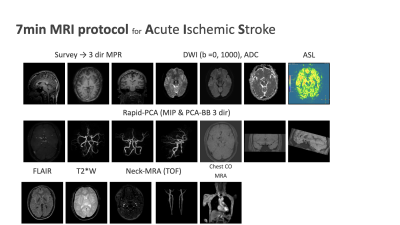Multi-lingual Session: Japan
ISMRT Education Session
ORGANIZERS: Shawna
Farquharson, Norio Hayashi, Eisuke Sato, Hiroyuki Takashima, Thao Tran
Sunday, 11 May 2025
Session Number: ISMRT-M02
CE Credit
Session Number:
ISMRT-M02
Overview
About 10 years ago, the clinical usefulness of mechanical thrombectomy
(MT) for acute ischemic stroke (AIS) was proven. This revolutionary
event significantly changed clinical practice in neuroimaging during the
acute stage. In the early period after its introduction in 2014, "Time
is brain" was the most common keyword in the treatment strategy of AIS.
Shortening of preoperative examination time and rapid decision making
for MT was required.
To overcome this issue, many studies have been conducted to develop
sophisticated MRI protocols for AIS, and the role of brain MRI has
drastically changed throughout the previous decade. As a result, the era
of "Imaging is brain" has arrived. Additionally, MRI is already not
considered to delay the treatment of AIS.
In line with these transitions in imaging strategies, we have been
striving for the past decade to improve our MRI protocols and develop
new rapid sequences for AIS. In this talk, we would like to describe the
role and knowledge of MRI and introduce our 7-min MRI protocol for acute
ischemic stroke.
Target Audience
Radiographers, Physicians, Radiologists, and Scientists.
Educational Objectives
As a result of attending this course, participants should be able to:
Understand the latest advancements in MRI technology and acquire skills
that can be immediately applied in clinical practice;
Understand the solutions to the challenges faced by Japanese
radiological technologists; and
Understand the role and impact of Japanese radiological technologists in
the international innovation of diagnostic technologies.
|
10:50 |
 |
10 Years Review, MRI for Acute Ischemic Stroke & Our Works
Oura Daisuke, Riku Ihara, Takumi Yokohama, Yoshimasa Niiya
Impact: The 7min-Acute ischemic stroke protocol
including ASL, black blood image, chest MRA.
|
|
11:20 |
|
What is Needed for a Comfortable Musculoskeletal MRI
Examination?
Yoshihiro Akatsuka
Impact: Musculoskeletal MRI requires high-resolution
images, but motion artifacts often degrade image quality.
Shorter musculoskeletal MRI exam times improve patient
comfort and reduce motion artifacts. I would like to talk
about patient positioning skills and exam planning.
|

